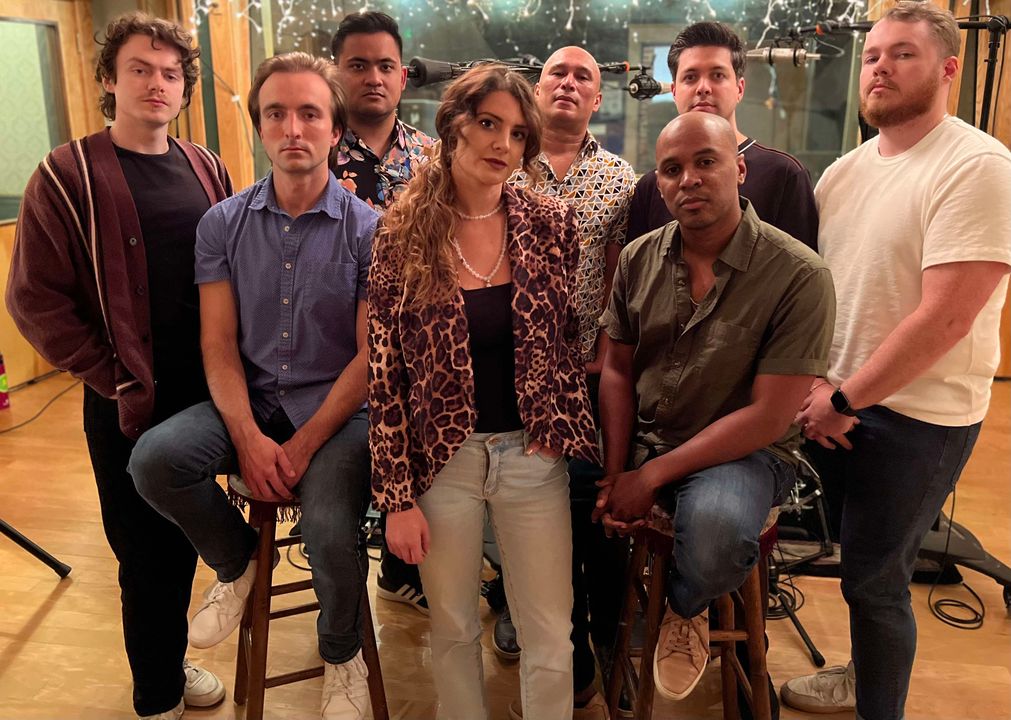New Release from Joyous Records
Sofia Goodman’s ‘Receptive’ and the Ideal Character
Human character, its content, strengths, failings, hypocrisy, depth and intimate shadings have long been the subject of artistic, and particularly musical, expression. It is said that the contrasting themes of the old symphonic first movement forms were meant to show the contrasting sides of a single individual. Similarly, in the song-cycle tradition, intricate depictions of different sides of a character were often an important expressive goal. At their best, character depictions in music are tellingly inward-looking for the artist (and perhaps listener’s) character, but at their worst, they are a mere excuse for creating a pastiche of genre. Music City’s Sofia Goodman’s newest release, the remarkable Receptive, while quite diverse in genre, lies firmly in the former group.
Receptive is a collection of eight pieces for octet that is organized around the stages and aspects of receptiveness, her “core value,” defining her character and investigating ours as we listen. Throughout the album, the musicianship in the octet is top notch—fluent, expressive with restraint and often immeasurably poignant. Goodman has recently received a lot of hype on the Music City Jazz Scene, and this album justifies that excitement.

The album opens with “Trust” which, reflecting the song’s title, features a tightly blended melody and an introspective improvisation from Blaise Hearn (trumpet) whose line and color are more mellow than brassy. It is an entry into Goodman’s sonic world, and here the ambiance and timbre can carry as much, if not more, interest than meter, mode and formal articulation— the sound of a rainstick for example, or a cymbal roll, are identical in formal function but differentiated in expressive color. In the second track, “Allow” Jovan Quallo’s flute solo evolves through waves of continuing variation (a kind of melodic thread that seems to run through the collection). While Lopez’s and Goodman’s solo felt almost obligatory, Leland Nelson’s (bass) bowed and pointed coda took my breath away. This is one of the other wonderful things that unify the album–transitional passages between tracks.
Raised in Boston, Goodman came on the scene there through Berklee, studying percussion. You can hear this background in the music’s constant rhythmic interest and an intriguing confidence heard in the arrangements. However, her melodies are even richer, probably a result of her time studying composition at Belmont University here in Music City.
The third track, “Channel” features Desmond Ng’s (trombone) surprisingly patient and melodic solo work whose eloquent diction (it’s almost a recitative) leans against Goodman’s driving rhythm section, breaking into a gentle Hispanic dance here and an equally traditional backbeat there, channeling the melody through these stylistic transitions.
The liner notes mention the “noir swing” of “The Space Within,” but I think the terms should be separated by a comma (re. noir, swing!). The bisectional head’s front delightfully suggests film noir’s flashbacks of dramatic development in staccato punches until that swing beat actually falls headlong on the back end. Goodman’s solo that culminates the song is wonderfully garish, leading, quite unexpectedly, to the track’s underwater coda; it’s as if they had fallen into a pool and kept playing, or did we fall into the pool? In anycase, the experimental gesture works somehow. This leads to the abstract, and almost free, fourth track “Socket.”
“Presence” returns to a beautiful melody that, it seems to me, communicates the idea of presence as being “in the moment.” Nelson’s solo is again exquisite, an expeditionary adventure that remains ever in the pocket. Dan Hitchcock’s saxophone solo in “Gratitude” is resoundingly virtuosic even as the track sets up the finale like an upbeat. The finale, “Receptive” completes the album providing closure to the grand sweep of the concept, framing out and unifying the album’s architecture in a celebration.
Listening to the entire album in one sitting makes for a wonderful moment away from the chaos and enriches the experience over listening to any individual track in isolation—in this way it is successful as an album. Does anyone listen to entire albums in one sitting anymore? However, the album, being true to the concept, is blatantly (and perhaps too) optimistic in nature. There are a number of examples of stylistic diversity in Goodman’s concept and composition, but each reaches for a related, positive expression (with the possible exception of the abstract “socket.”) After the collection, as a listener, I longed for a little more expressive contrast. I’m thinking of the forward aggression of Goodman’s “Sea Legs” from Secrets of the Shore, or check out “Navigator.” One wonder’s how Goodman might have approached the expression of some of the darker and uglier sides of human character. That said, the universe of Receptive is an idealized world we would all be lucky to visit.
In sum, by being in Music City, Goodman has managed to surround herself with a group of fantastic musicians capable of articulating her ideals in a beautiful clarity; it is a great album from a rising star on the scene. Receptive will be released by Joyous Records on July 26 and may be purchased (or preordered) through Goodman’s website here: https://www.thesofiagoodmangroup.com/. The Sofia Goodman Group will be appearing at Analog in Nashville to celebrate its release on July 29th.




